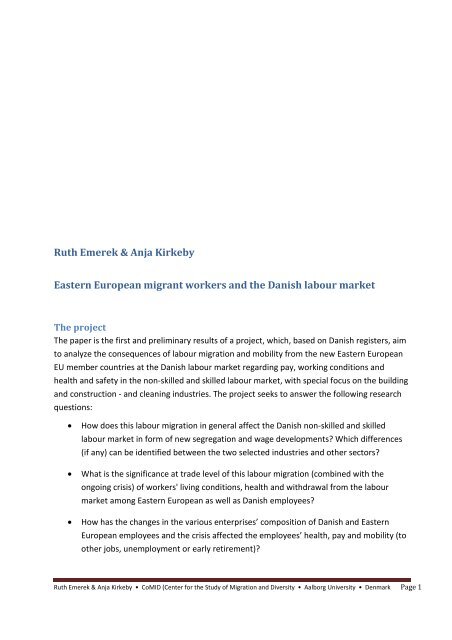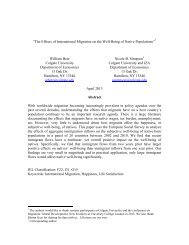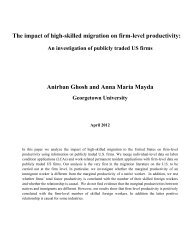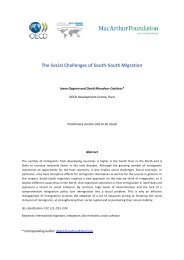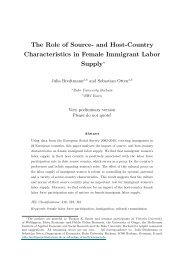Eastern European migrant workers and the Danish labour ... - CReAM
Eastern European migrant workers and the Danish labour ... - CReAM
Eastern European migrant workers and the Danish labour ... - CReAM
Create successful ePaper yourself
Turn your PDF publications into a flip-book with our unique Google optimized e-Paper software.
Ruth Emerek & Anja Kirkeby<strong>Eastern</strong> <strong>European</strong> <strong>migrant</strong> <strong>workers</strong> <strong>and</strong> <strong>the</strong> <strong>Danish</strong> <strong>labour</strong> marketThe projectThe paper is <strong>the</strong> first <strong>and</strong> preliminary results of a project, which, based on <strong>Danish</strong> registers, aimto analyze <strong>the</strong> consequences of <strong>labour</strong> migration <strong>and</strong> mobility from <strong>the</strong> new <strong>Eastern</strong> <strong>European</strong>EU member countries at <strong>the</strong> <strong>Danish</strong> <strong>labour</strong> market regarding pay, working conditions <strong>and</strong>health <strong>and</strong> safety in <strong>the</strong> non-skilled <strong>and</strong> skilled <strong>labour</strong> market, with special focus on <strong>the</strong> building<strong>and</strong> construction - <strong>and</strong> cleaning industries. The project seeks to answer <strong>the</strong> following researchquestions:How does this <strong>labour</strong> migration in general affect <strong>the</strong> <strong>Danish</strong> non-skilled <strong>and</strong> skilled<strong>labour</strong> market in form of new segregation <strong>and</strong> wage developments? Which differences(if any) can be identified between <strong>the</strong> two selected industries <strong>and</strong> o<strong>the</strong>r sectors?What is <strong>the</strong> significance at trade level of this <strong>labour</strong> migration (combined with <strong>the</strong>ongoing crisis) of <strong>workers</strong>' living conditions, health <strong>and</strong> withdrawal from <strong>the</strong> <strong>labour</strong>market among <strong>Eastern</strong> <strong>European</strong> as well as <strong>Danish</strong> employees?How has <strong>the</strong> changes in <strong>the</strong> various enterprises’ composition of <strong>Danish</strong> <strong>and</strong> <strong>Eastern</strong><strong>European</strong> employees <strong>and</strong> <strong>the</strong> crisis affected <strong>the</strong> employees’ health, pay <strong>and</strong> mobility (too<strong>the</strong>r jobs, unemployment or early retirement)?Ruth Emerek & Anja Kirkeby • CoMID (Center for <strong>the</strong> Study of Migration <strong>and</strong> Diversity • Aalborg University • Denmark Page 1
with special focus on <strong>the</strong> skilled <strong>and</strong> non-skilled <strong>labour</strong> market. The purpose is to identifyinappropriate development trends <strong>and</strong> on that basis, produce concrete solutions, such asmanagement strategies <strong>and</strong> tools for <strong>the</strong> reception <strong>and</strong> inclusion of <strong>the</strong> new <strong>workers</strong> from<strong>Eastern</strong> Europe. The need to examine conditions for this type of <strong>labour</strong> migration is reinforcedby indications that an increasing proportion of <strong>the</strong>se <strong>labour</strong> <strong>migrant</strong>s choose to settle inDenmark, turning <strong>labour</strong> migration/mobility into immigration. This development can be tracedin <strong>the</strong> growing number of new <strong>and</strong> very young dependants originating from <strong>the</strong> new EUcountries (see figure below).Sources: Statistics Denmark, Statistikbanken, KRBEF3 <strong>and</strong> FOLK1Fur<strong>the</strong>rmore <strong>the</strong> economic crisis has apparently not stopped immigration from <strong>the</strong> East (seefigure next page); official <strong>Danish</strong> statistics reveal almost 46,000 im<strong>migrant</strong>s of <strong>the</strong> working age20-59 years from <strong>the</strong> <strong>Eastern</strong> <strong>European</strong> EU countries in Denmark at <strong>the</strong> beginning of 2012,more than twice as many as at <strong>the</strong> beginning of 2007 (13). The growth has been especiallyRuth Emerek & Anja Kirkeby • CoMID (Center for <strong>the</strong> Study of Migration <strong>and</strong> Diversity • Aalborg University • Denmark Page 3
strong among young men in <strong>the</strong> late twenties to late thirties. Authorities <strong>and</strong> professionalorganizations estimate that <strong>the</strong>re are similar numbers of irregular <strong>migrant</strong> <strong>workers</strong> withoutwork permits.Sources: Statistics Denmark, Statistikbanken, KRBEF3 <strong>and</strong> FOLK1The inclusion of <strong>the</strong> 10 East <strong>European</strong> countries into <strong>the</strong> EU from 2004 <strong>and</strong> onwards has meantchanges in <strong>the</strong> <strong>European</strong> migration patterns with a significant flow from East to West – also forDenmark - despite <strong>the</strong> fact that Denmark until 2009 has had an ' East-agreement ' with <strong>the</strong>requirement that <strong>workers</strong> from <strong>the</strong> eight <strong>Eastern</strong> <strong>European</strong> EU countries, which were includedin <strong>the</strong> EU per 1. May 2004 as well as Bulgaria <strong>and</strong> Romania (from 2007), in a transitional phaseshould have a residence <strong>and</strong> a work permit before <strong>the</strong>y could work for a <strong>Danish</strong> employer (9).Ruth Emerek & Anja Kirkeby • CoMID (Center for <strong>the</strong> Study of Migration <strong>and</strong> Diversity • Aalborg University • Denmark Page 4
The aim was to ensure <strong>the</strong> new <strong>Eastern</strong> <strong>European</strong> <strong>workers</strong> acceptable wages <strong>and</strong> workingconditions on <strong>the</strong> <strong>Danish</strong> <strong>labour</strong> market, as well as ensuring that working conditions for <strong>Danish</strong><strong>workers</strong> were not impaired (25). The gradual phase-out of <strong>the</strong> East-agreement, however, hasincreased <strong>the</strong> possibility of various forms of exploitation of <strong>the</strong> new <strong>Eastern</strong> <strong>European</strong> <strong>workers</strong>,both in <strong>Danish</strong> jobs <strong>and</strong> in connection with sub-contracting. This – toge<strong>the</strong>r with <strong>the</strong> fastgrowing number of <strong>Eastern</strong> <strong>European</strong> <strong>workers</strong> - challenges <strong>the</strong> norms <strong>and</strong> traditions of <strong>the</strong><strong>Danish</strong> <strong>labour</strong> market <strong>and</strong> can result in deterioration of occupational health <strong>and</strong> safety of bothim<strong>migrant</strong> <strong>and</strong> <strong>Danish</strong> <strong>workers</strong>, for example, <strong>the</strong> want for more time <strong>and</strong> more overtime work,involve potential conflicts between <strong>the</strong> various groups. Previous studies of immigration before<strong>the</strong> crisis has shown that it is mainly younger Danes without education, who are paying <strong>the</strong>price for immigration in <strong>the</strong> form of lower wages <strong>and</strong> lost jobs/changes (32,33). The problemsmay be enlarged by <strong>the</strong> fact that East-agreement was phased out at <strong>the</strong> time <strong>the</strong> crisis <strong>and</strong>unemployment grew, <strong>and</strong> <strong>the</strong> already declining employment in <strong>the</strong> male-dominated jobs forskilled <strong>and</strong> non-skilled <strong>workers</strong> declined fur<strong>the</strong>r (17).Push <strong>and</strong> pull factors<strong>Eastern</strong> <strong>European</strong> <strong>labour</strong> <strong>migrant</strong>s go to Denmark or o<strong>the</strong>r Western <strong>European</strong> countries in <strong>the</strong>expectation of higher wages, better working conditions <strong>and</strong> social conditions <strong>and</strong>/or because<strong>the</strong> socio-economic conditions are generally poor (inter alia, higher unemployment <strong>and</strong> lowerwages) in <strong>the</strong> <strong>Eastern</strong> Europe countries (21, 16, 49).There are thus both pull <strong>and</strong> push factorsbehind <strong>the</strong> migration (11). Migrant <strong>workers</strong> are in many cases prepared to accept <strong>the</strong> so-called3-d jobs (Dirty, Dangerous <strong>and</strong> Demeaning), which are characterized by having a high risk ofinjuries <strong>and</strong> accidents. The acceptance of flexibility with regard to working time <strong>and</strong> length aswell as <strong>the</strong> generally poor working conditions must, <strong>the</strong>refore, be assumed to be high among<strong>migrant</strong> <strong>workers</strong> (21), who also will have limited knowledge of <strong>Danish</strong> agreements, taxconditions <strong>and</strong> rules on occupational health <strong>and</strong> safety, <strong>and</strong> relatively few of <strong>the</strong> <strong>migrant</strong><strong>workers</strong> are members of a <strong>Danish</strong> Trade Union (22). Migrant <strong>workers</strong> also lack knowledge of <strong>the</strong><strong>Danish</strong> language <strong>and</strong> <strong>Danish</strong> working <strong>and</strong> safety culture (25). A recent report shows that socialdumping is widespread <strong>and</strong> that <strong>the</strong>re is a lack of knowledge about social rights (36). Thesefactors, combined with <strong>the</strong> poor housing, wages lower than <strong>the</strong> minimum wage, illegal longworking days <strong>and</strong> breach of security requirements with work accidents, implies a risk ofweakening of a number of working conditions on <strong>the</strong> <strong>Danish</strong> <strong>labour</strong> market. This also suggeststhat <strong>Eastern</strong> <strong>European</strong> <strong>workers</strong>' increasing share of <strong>the</strong> <strong>labour</strong> force in Denmark has hadsignificance for a fur<strong>the</strong>r <strong>and</strong> new segregation of work, both on <strong>the</strong> <strong>labour</strong> market <strong>and</strong> atworkplace level.Ruth Emerek & Anja Kirkeby • CoMID (Center for <strong>the</strong> Study of Migration <strong>and</strong> Diversity • Aalborg University • Denmark Page 5
There are as yet no published studies on <strong>the</strong> significance of changes in <strong>the</strong> composition of <strong>the</strong>workforce at <strong>the</strong> enterprise level for <strong>the</strong> employees ' living conditions (salary, job opportunities,health <strong>and</strong> accidents), but studies of organizational changes in <strong>Danish</strong> companies have shownthat changes can lead to health problems (26).New knowledgeThe project will contribute with new knowledge about <strong>the</strong> importance of globalisation – here inparticular <strong>the</strong> importance of <strong>labour</strong> migration from <strong>the</strong> new EU countries from <strong>Eastern</strong> Europewith regard to health, working conditions <strong>and</strong> environment on skilled <strong>and</strong> non-skilled jobs. Theproject will, among o<strong>the</strong>r things, identify <strong>the</strong> cooperation <strong>and</strong> potential tensions between<strong>Eastern</strong> <strong>European</strong> <strong>workers</strong> <strong>and</strong> <strong>Danish</strong> <strong>workers</strong> as well as former <strong>and</strong> new potential segregationon <strong>the</strong> <strong>labour</strong> market. Fur<strong>the</strong>rmore, <strong>the</strong> project puts focus on how safety culture is developingalong with <strong>the</strong> changes <strong>the</strong> free mobility of <strong>labour</strong> is creating on <strong>the</strong> <strong>Danish</strong> <strong>labour</strong> market. Theproject will thus qualify <strong>the</strong> debate on <strong>the</strong> organisation of <strong>the</strong> future <strong>Danish</strong> <strong>labour</strong> market for<strong>the</strong> benefit of both <strong>workers</strong> <strong>and</strong> employers/business <strong>and</strong> <strong>the</strong> <strong>Danish</strong> society.The lack of knowledge of <strong>migrant</strong> <strong>workers</strong>' working conditions also means that <strong>the</strong>re is a lack oftools to facilitate <strong>the</strong> <strong>migrant</strong> <strong>workers</strong>' inclusion <strong>and</strong>, in <strong>the</strong> long term retention on <strong>the</strong> <strong>Danish</strong><strong>labour</strong> market, <strong>and</strong> to ensure <strong>the</strong> retention of <strong>the</strong> current <strong>Danish</strong> st<strong>and</strong>ard for <strong>the</strong> workingenvironment, working conditions <strong>and</strong> wage levels. It is <strong>the</strong> research initiative’s vision tocontribute with new knowledge <strong>and</strong> practical tools for <strong>the</strong> management <strong>and</strong> h<strong>and</strong>ling of <strong>the</strong>change <strong>and</strong> <strong>the</strong> growing diversity, as <strong>the</strong> free mobility of <strong>labour</strong> in <strong>the</strong> EU has created on <strong>the</strong><strong>Danish</strong> <strong>labour</strong> market.The research initiative focuses specifically on <strong>the</strong> construction <strong>and</strong> cleaning industry, but at <strong>the</strong>same time, examines <strong>the</strong> extent to which <strong>the</strong> problems <strong>and</strong> <strong>the</strong>refore <strong>the</strong> results can begeneralized from <strong>the</strong>se two industries. The two industries are chosen for several reasons: bothindustries have a high concentration of <strong>Eastern</strong> <strong>European</strong> <strong>workers</strong>; in both industries, work isrisky in relation to accidents <strong>and</strong> health; <strong>the</strong> one industry (construction/plant) is maledominated<strong>and</strong> <strong>the</strong> o<strong>the</strong>r (cleaning) traditionally female dominated, <strong>and</strong> <strong>the</strong> two branches of alinear transformation between <strong>the</strong> spectrum of <strong>the</strong> status of a skilled trade <strong>and</strong> <strong>the</strong> lowestimated cleaning work.Ruth Emerek & Anja Kirkeby • CoMID (Center for <strong>the</strong> Study of Migration <strong>and</strong> Diversity • Aalborg University • Denmark Page 6
Preliminary resultsSurvival <strong>and</strong> duration analysis reveal that almost half <strong>the</strong> <strong>migrant</strong>s from <strong>the</strong> new <strong>Eastern</strong><strong>European</strong> EU-countries settle in Denmark for a longer period.Five years (60 months) after <strong>the</strong> <strong>the</strong>ir first encounter into Denmark since <strong>the</strong> EU-enlargementbetween 20 % (from Bulgaria) <strong>and</strong> 60% (from Czech Republic) of <strong>migrant</strong>s from <strong>the</strong> various<strong>Eastern</strong> <strong>European</strong> EU-countries have left Denmark (figure next page).A duration analysis on first entrance to first exit after <strong>the</strong> EU-enlargement shows that origin (inform of citizenship) has significant influence on <strong>the</strong> duration of stay. Migrants from Romania<strong>and</strong> Bulgaria have a twice as long an estimated continuous first stay than o<strong>the</strong>r eastern<strong>European</strong> <strong>migrant</strong>s.Migrants who stayed a period in Denmark before <strong>the</strong> EU-enlargement <strong>and</strong> prior to <strong>the</strong> end of<strong>the</strong> special <strong>Danish</strong> East agreement had a shorter stay than persons immigrated after (83%).Women have a significant longer stay than men, while age at immigration seems less importantexcept for <strong>migrant</strong>s younger than 30 years of age.Ruth Emerek & Anja Kirkeby • CoMID (Center for <strong>the</strong> Study of Migration <strong>and</strong> Diversity • Aalborg University • Denmark Page 7
The result fur<strong>the</strong>rmore suggests that <strong>the</strong> regulations in form of <strong>the</strong> East Agreement (which isnow repealed) had some impact on <strong>the</strong> time of stay.The duration analysis below is based on 45.326 im<strong>migrant</strong>s aged 18-64 years.Parameter Estimate Ratio -expectedsurvivaltimeIntercept 4,71* .Country of origin/Citizen Ship Czech Republic -0,93* 40%Slovenia -0,73* 48%Slovakia -0,37* 69%Hungary -0,21* 81%Estonia -0,08 ns 92%Lithuania 0,11* 112%Latvia 0,14* 115%Romania 0,75* 212%Bulgaria 0,85* 235%Pol<strong>and</strong> . .Sex Women 0,39* 147%Men . .Age at immigration 60-65 years 0,61 ns 183%55-59 years 0,03 ns 103%50-54 years -0,04 ns 96%45-49 years 0,01 ns 101%40-44 years 0,02 ns 102%35-39 years 0,02 ns 102%25-29 years -0,17* 84%18-24 years -0,74* 48%30-34 years . .Residence in DK before enlargement -0,07 ns 93%No residence in DK before enlargement . .Immigrated before end of East Agreement -0,19* 83%Immigrated after end of East agreement . .Scale 1,75 .*Pr
References – direct <strong>and</strong> indirect.1 Ahonen EQ, Benadevídes FG, Benach J. (2007)Im<strong>migrant</strong> populations, work <strong>and</strong> health - asystematic literature review. Sc<strong>and</strong> j work Environ Health 2007; 33:96-1042 Andersen og Hansen (2008): Østeuropæiske arbejdere I bygge- og anlægsbranchen. FAOS,Københavns universitet.3 Andersen, Søren Kaj (2010): Østeuropæerne og presset på overenskomstmodellen, Analyse,Politikken.4 Anderson, B. & Ruhs, M. (2006): Semi-compliance in <strong>the</strong> <strong>migrant</strong> <strong>labour</strong> market. Workingpaper no 30, Center on migration, policy <strong>and</strong> society, University of Oxford.5 Anmeldte arbejdsulykker 2005-10. Arbejdstilsynets årsrapport 2010, 2. udgave.Arbejdstilsynet, København, 2011.6 Antoft, Rasmus & Thomsen, Trine L.( 2005). Når livsfortællinger bliver en sociologiskmetode. I Jacobsen et al. Liv, Fortælling og tekst – strejftog i kvalitativ sociologi. AalborgUniversitetsforlag.7 Attas, D. (2000): The Case of Guest Workers: Exploitation, Citizenship <strong>and</strong> Economic Rights,v6 n1, Springer8 Benavides et al. (2006): “Associations between temporary employment <strong>and</strong> occupationalinjury: what are <strong>the</strong> mechanisms?”. Occup. Environ. Med 2006:639 Bering I. (2009): Når det dårlige arbejde også er godt. Medarbejderperspektiver på ændretarbejdsorganisering i rengøringsbranchen. Ph.d. afh<strong>and</strong>ling, Roskilde Universitetsforlag,2009.10 Beskæftigelsesministeriet (2003):http://bm.dk/da/Aktuelt/Politiske%20aftaler/Oestaftalen.aspx11 Beskæftigelsesministeriet (2008). H<strong>and</strong>lingsplan ‘Antallet af arbejdsulykker skal nedbringes’.København 2008.12 Castles, S. & Miller, M.J. (2009): The Age of Migration. Palgrave Macmillan.13 Collins CP.(1959): Accidents in a naval dockyard. British Journal of Industrial Medicine. 1959;16:208−215.14 Dahl, Michael S. (2011): Organizational Change <strong>and</strong> Employee Stress, Management Science,Vol. 57, Nr. 2, 02.2011, s. 240-256.15 Danmarks Statistik, Statistikbanken, KRBEF3 og FOLK116 Doos M, Laflamme L, Backstrom T. (1994): Im<strong>migrant</strong>s <strong>and</strong> occupational accidents: Acomparative study of <strong>the</strong> frequency <strong>and</strong> types of accidents encountered by foreign <strong>and</strong>Swedish citizens at an engineering plant in Sweden. Saf Sci 1994;18(1):15-32.17 Düvell, F. (2008): Cl<strong>and</strong>estine migration in Europe. Social Research Information, vol 47, no479, Sage publications.18 Dølvik, J.E. & L. Eldring (2008): Arbejdsmobilitet fra de nye EU-l<strong>and</strong>ene til Norden –Utviklingstrekk og konsekvenser, København, Nordisk Ministerråd.19 Emerek, Ruth og Helle Holt (2008): ’Det kønsopdelte danske arbejdsmarked’ i Emerek, Ruthog Helle Holt eds.: Lige Muligheder – Frie Valg, Om det kønsopdelte arbejdsmarked gennemet årti, SFI, 08:24.20 <strong>European</strong> Agency for Safety <strong>and</strong> Health at Work (2007): “Working safely in a multiculturalHorea sector”. Forum 2007:1721 <strong>European</strong> Agency for Safety <strong>and</strong> Health at Work. Literature study of <strong>migrant</strong> <strong>workers</strong>. 2007.http://osha.europa.eu/en/publications/literature_reviews/<strong>migrant</strong>_<strong>workers</strong>/view22 Favell A. (2008):The new face of East-West migration in Europe. Journal of Ethnic <strong>and</strong>Migration Studies 2008;34(5):701-716.23 Hansen JA, Hansen NW. (2011): Nye arbejds<strong>migrant</strong>er på det danske arbejdsmarked. In:Larsen TP(, editor. Insidere og Outsidere - Den danske models rækkevidde København: JuristRuth Emerek & Anja Kirkeby • CoMID (Center for <strong>the</strong> Study of Migration <strong>and</strong> Diversity • Aalborg University • Denmark Page 9
og Økonomforbundets Forlag;.24 Hansen JA, Hansen NW (2009): Polakker på det danske arbejdsmarked - frie fugle eller nyr<strong>and</strong>gruppe? Tidsskrift for Arbejdsliv 2009;11(2):24-40.25 Hansen og Hansen, FAOS (2009): ”Polonia i København –Et studie af polskearbejds<strong>migrant</strong>ers løn-, arbejds- og levevilkår i Storkøbenhavn”.25 Hansen, J.A. & Hansen, N.W. (2009): Polonia i København – Et studie af polskarbejds<strong>migrant</strong>ers løn-, arbejds-, og levevilkår i Storkøbenhavn, København. LOdokumentation2009:126 Hoerning, Erika (1996): Life Course <strong>and</strong> Biography: Approaches <strong>and</strong> Methods. AalborgUniversitet, Institut for samfundsudvikling og planlægning. Paperserie nr. 199.27 Hofstede G.(1984): Culture consequenses, International differencies in work-relatedvalues.Abridged edition. Sage Publications, London, 1984.28 Hunt SM, Bhopal R. Self report in clinical <strong>and</strong> epidemiological studies with non-englishspeakers. The challenge of language <strong>and</strong> culture. Br Med J, 2004; 58: 168.29 Hviid, K. & M. A. Flyholm (2010): Udenl<strong>and</strong>sk arbejdskraft i Norden – Sammenfatning afl<strong>and</strong>erapparter fra forprojekt til Nordisk Ministerråds globaliseringsprojekt, NordiskMinisterråd. TemaNord 2010:588.30 Høyer Rohde A, Pljevaljcic D (2011):. Resultater af pilotstudiet om arbejds<strong>migrant</strong>er.Arbejdsmedicinsk Klinik i Herning 2011 Fortrolig, intern rapport:1-69.31 Jenkins, R. (2008). Rethinking Ethnicity. London, Sage Publications32 Jensen FN, Frydendall KD, Flyvholm MA. (2011): Vocational training courses <strong>and</strong>intervention. A change of work practise among im<strong>migrant</strong> cleaners. Am J Ind Med, 2011, e-pub.33 Jørgensen MB et al. (2010): Health disparities between im<strong>migrant</strong>s <strong>and</strong> <strong>Danish</strong> cleaners. IntArch Environ Health. 2010.34 Jørgensen MB et al. Succesfull reach <strong>and</strong> adoption of a workplace health promotionintervention study targeting a group of high risk <strong>workers</strong>. A r<strong>and</strong>omised controlled clinicaltrial among cleaners. BMC Med Res Method, 2010; 10:56.35 Malchow_Møller, Nikolaj et al (2007): Udenl<strong>and</strong>s arbejdskraft i Danmark – Konsekvenser forløn og beskæftigelse, Arbejdspapir 16, Rockwool Fondens Forskningsenhed, København36 Malchow_Møller, Nikolaj et al eds. (2009): Det danske arbejdsmarked og EU-udvidelsenmod øst, Gyldendal,37 Martin, Philip et al. (2006): Managing Labour Migration in <strong>the</strong> Twenty-First Century.London: Yale University Press.38 Mearns K, Yule S. (2009): The role of national culture in determining safety performance:Challenges for <strong>the</strong> global oil <strong>and</strong> gas industry. Saf Sci 2009;47(6):777-785.39 Pedersen, Klaus & Søren Kaj Andersen (2008): Det udvidede EU og den fri bevægelighed forØsttjenesteydere, FAOS 096, Københavns Universitet.40 Pedersen LM, Thomsen TL. (2011): Arbejdsmigration fra de nye EU-l<strong>and</strong>e - En kilde til væksteller en trussel mod de (u)faglærte danske arbejdstagere? Tidsskrift for Arbejdsliv2011;13(3):45-63.41 Pedersen, L & Thomsen, T.L. (2011). Arbejdsmigration fra de nye EU-l<strong>and</strong>e – en kilde tilvækst eller en trussel mod de (u)faglærte danske arbejdstager. Tdisskrift for Arbejdsliv, 13årg. Nr.3.42 Personlig meddelelse, Hasse Mortensen, tilsynschef, Arbejdstilsynet, 201143 Porthé V, Ahonen E, Vázquez ML, Pope C, Agudelo AA, García AM, et al. (2010: Extending amodel of precarious employment: A qualitative study of im<strong>migrant</strong> <strong>workers</strong> in Spain. Am JInd Med 2010;53(4):417-424.44 Probst TM, Brubaker TL. (201): The effects of job insecurity on employee safety outcomes:Cross-sectional <strong>and</strong> longitudinal explorations. J Occup Health Psychol 2001;6(2):139-159.Ruth Emerek & Anja Kirkeby • CoMID (Center for <strong>the</strong> Study of Migration <strong>and</strong> Diversity • Aalborg University • Denmark Page 10
45 Rasmussen CDN et al. (2011): Participation of <strong>Danish</strong> <strong>and</strong> im<strong>migrant</strong> cleaners in a 1-yearwork site intervention preventing physical deterioration. Ergonomics , aug 2011, e-pub.46 Saksvik PØ, Dahl-Jørgensen C, Eiken TE, Tvedt SD. (2010): Identity, Over-Commitment, WorkEnvironment, <strong>and</strong> Health Outcomes among Im<strong>migrant</strong> Workers. Journal of Identity <strong>and</strong>Migration Studies 2010;4(2):2-23.47 Salminen S, Vartia M, Giorgiani T. (2009): Occupational Injuries of im<strong>migrant</strong> <strong>and</strong> Finnish busdrivers. Journal of Safety Research, 2009; 40:203-205.48 Soares JJF, Grossi G. (2009): Expirience of musculo skeletal pain- comparison of im<strong>migrant</strong><strong>and</strong> Swedish patients. Sc<strong>and</strong> J Caring Sci. 2009; 13. 254-60.49 Social dumping og unfair konkurrence. Notat, BAT kartellet, København, 2011.50 Sorock GS et al. (2004): A case-cros over study of transient risk factors for occcupationalacute h<strong>and</strong> injury. occup Environ Health 2004; 61:305-311.51 Thomsen TL.(2010): Conceptual reflections - transcending <strong>the</strong> legal aspects of irregularmigration. Irregular Migration in a Sc<strong>and</strong>inavian Perspective. Thomsen, T.L.; Jørgensen,M.B.; Meret, S.; Hviid, K.; Stenum, H. ed.: Shaker Publishing Maastricht; 2010. p. 27-47.52 Thomsen, Trine L. (2010): Tales of <strong>the</strong> Polish Plumber - Irregular migration in Denmark after<strong>the</strong> EU enlargement, i Lund Thomsen m.fl. (red.): Irregular Migration in a Sc<strong>and</strong>inavianPerspective, Maastricht, Shaker Publishing, 155-179.53 Unge J et al. (2007): Differencies in physical work load <strong>and</strong> psychosocial factors <strong>and</strong>musculoskeletal disorders between two groups of hospital cleaners with two diversedorganizational models. Int Arch Environ Health, 2007, 81. 2009-20.54 Weishaar HB. (2008): Consequences of international migration: A qualitative study on stressamong Polish <strong>migrant</strong> <strong>workers</strong> in Scotl<strong>and</strong>. Public Health 2008;122(11):1250-1256.55 Wrench, J.( 2007): Diversity Management <strong>and</strong> Discrimination, Hampshire, AshgatePublishing Limited.Ruth Emerek & Anja Kirkeby • CoMID (Center for <strong>the</strong> Study of Migration <strong>and</strong> Diversity • Aalborg University • Denmark Page 11


